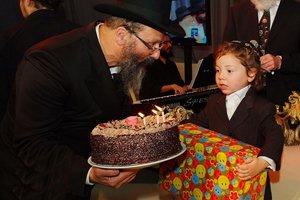|
|

|
|
Home
» Magazine
» Upsherin: A Custom that Goes without Saying
|
|
Upsherin: A Custom that Goes without Saying
by Rabbi Yossi Braun
|
Question:
I just received your invitation to your son Shneur's third birthday and upsherenish (first haircut) bash. I wish you and your wife continued nachas from him and the rest of the brood.
While I appreciate the invitation, I must tell you rabbi, that I don't understand the "big fuss" over his first haircut.
I actually googled it up and I discovered that there are virtually no references to this custom in earlier sources, nor does it appear in the Shulchan Aruch (Code of Jewish Law).
What do you make of this?
Answer:
Historical research and pertinent facts aside, the celebration of a three year old child's haircut has developed into a minhag yisrael (traditionalJewish custom) and is practiced in Jewish communities the world over.
I am, however, in full agreement that this custom has absolutely no halachic source. [It does, however, feature in Kabbala, as well as some later sources].
Although this custom possesses beautiful symbolisms, it appears that it has not been prevalent in many Jewish communities of ancient times. To quote Rabbi Shneur Zalman of Kopust: "This is not mentioned in the Code of Jewish law nor in any other source. Even Rabbi Jacob Emden who goes through all lifecycles from birth onwards omits completely any mention of this custom."
And that's what makes it so special. While all other lifecycle celebrations are mandated in Jewish law, the custom of upsherin originates from within. It is our own home-grown celebration.
Happiness is a choice coming from within. A celebration which is dictated from above can't really bring true happiness. You can let your hair down, enjoy yourself and have a good time but you won't experience true joy. However, when you "call the shots", it's happiness on your terms.
When we invite our friends over to cut down those beautiful curls and party away, we are giving the following message to Mr. three year old, baby-turned toddler:
"Until now you were a cute little baby, adored by all and looked after by all. You had to be held, fed, diapered and pampered. You were sheltered and protected. It's now time to move on, out of home and immediate family into a big school with lots of people. You're no longer a little baby who can be mistaken for a girl. You have become a big independent boy.
"And, therefore, it's time to take responsibility for your own actions and feelings. Don't let your mood be swayed by what someone did or said - or didn't do and didn't say. The key to your happiness lies in your hands only. "
[Now for the Kabbalistic spin: Traditionally, the haircut ceremony is highlighted by leaving pay'ot, the distinctively Jewish side curls, right above the child's future beard (he will still have some time to start growing the beard...).
According to Kabbala, the "thirteen strands" of the beard are representative of the thirteen strands of the supernal "beard", G-d's thirteen Attributes of Mercy. These thirteen attributes are the foundation of the seder histhalshelut ("order of concatenation and evolution"), the first link in the cosmic "chain of worlds" extending from heaven to earth. Growing a beard allows us to retrace the tracks and climb up beyond the top step of the cosmic ladder.
But, the two side curls right above the face and beard, sidestep this very phenomena of "evolution," "cause and effect" and "process". If growing a beard connects us with our Ultimate Source and Cause , then leaving pay'ot affords us a glimpse of the undefined and infinite reality of G-d, Who transcends the very concept of source, cause and order.
No wonder this "custom" didn't "descend" into ink and paper, chapter and verse. It defies any concept of source and cause].
|
|
|
|
|

